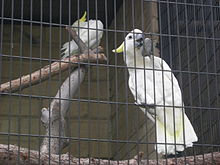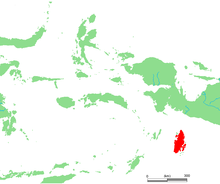- Eleonora Cockatoo
-
Eleonora Cockatoo 
Conservation status Scientific classification Kingdom: Animalia Phylum: Chordata Class: Aves Order: Psittaciformes Family: Cacatuidae Subfamily: Cacatuinae Genus: Cacatua Species: Cacatua galerita Subspecies: C. g. eleonora Trinomial name Cacatua galerita eleonora
Finsch, 1863Aru Islands (in red) The Eleonora Cockatoo, Cacatua galerita eleonora, also known as Medium Sulphur-crested Cockatoo, is similar in appearance to other subspecies of the Sulphur-crested Cockatoo. It is found in the Aru and Kai Islands of Indonesia, where it was introduced[1][2] and is common in aviculture.
It is the smallest of the four subspecies of Cacatua galerita, at approx. 44 cm long and weighing in at between 404–602 grammes.[3] Apart from the size difference, the Eleonora differs from the Greater Sulphur Crested in that it doesn't have as prominent white eyerings, the crest of an Eleonora is often less curved and it doesn't have the certain pointy upper mandible, which is only found in Cacatua galerita galerita.
The Eleonora Cockatoo was named by Dr. Otto Finsch. He discovered the subspecies in Amsterdam's Artis zoo and named it after Maria Eleonora van der Schroef, the wife of the then director of the zoo.
Contents
Diet and habitat
In the wild, the Eleonora Cockatoo is found in open woodlands, forests, and semi-arid forested areas, as well as partially cleared forest areas. It feeds on nuts, berries, flower buds, flowers, seeds and insects.[4]
Reproduction
The breeding season of this cockatoo is mainly from September to January. The birds build their nests in a tree hollow or rock crevice. The female lays 2-3 white oval eggs, which hatch after a period of 30 days. Both parents incubate the eggs and in turn provide for the chicks. The young fledge after about 75 days.
Intelligence and beat perception
One notable Eleonora Cockatoo is Snowball, a bird recently demonstrated to be capable of beat induction - in other words, that the bird is capable of perceiving a musical beat and dancing to it.[5]
References
- ^ "Sulphur-crested Cockatoo (Cacatua galerita)". Parrot Encyclopedia. World Parrot Trust. http://www.parrots.org/index.php/encyclopedia/wildstatus/sulphur_crested_cockatoo/. Retrieved 20 August 2010.
- ^ http://www.birdsnways.com/cockatoo/sc.htm
- ^ "ANIMAL BYTES — Medium Sulpher-crested Cockatoo". http://www.seaworld.org/Animal-info/animal-bytes/animalia/eumetazoa/coelomates/deuterostomes/chordata/craniata/aves/psittaciformes/medium-sulpher-crested-cockatoo.htm. Retrieved 2009-02-24.
- ^ "Birds >> Parrots >> Cockatoo — Eleonora Main Page". centralpets.com. http://www.centralpets.com/animals/birds/parrots/prt838.html. Retrieved 2009-02-25.
- ^ Patel, Aniruddh D.; Iversen, John R.; Bregman, Micah R.; Schulz, Irena & Schulz, Charles (2008-08), "Investigating the human-specificity of synchronization to music", Proceedings of the 10th Intl. Conf. on Music Perception and Cognition (Adelaide: Causal Productions)
External links
Cockatoos (family: Cacatuidae) Appearance Small NymphicusBlack Calyptorhynchus
(subgenus)Zanda
(subgenus)ProboscigerPink or grey CallocephalonEolophusLophochroaWhite CacatuaCacatua
(subgenus)Yellow-crested Cockatoo (or Lesser Sulphur-crested Cockatoo) (supporting page: Citron-crested Cockatoo) • Sulphur-crested Cockatoo (supporting page: Eleonora Cockatoo) • Blue-eyed Cockatoo • White Cockatoo (or Umbrella Cockatoo) • Salmon-crested Cockatoo (or Moluccan Cockatoo)Licmetis
(subgenus)Long-billed Corella • Western Corella (supporting pages: Muir's Corella • Butler's Corella) • Little Corella • Tanimbar Corella (or Goffin's Cockatoo) • Solomons Cockatoo • Red-vented Cockatoo
This article relating to parrots is a stub. You can help Wikipedia by expanding it.


